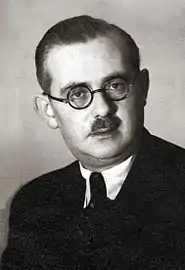Hilary Minc
Hilary Minc (24 August 1905, Kazimierz Dolny – 26 November 1974, Warsaw) was a Polish economist and communist politician prominent in Stalinist Poland.
Hilary Minc | |
|---|---|
 Hilary Minc in 1949. | |
| Deputy Prime Minister of Poland | |
| In office 20 April 1949 – 10 October 1956 | |
| Prime Minister | Józef Cyrankiewicz (1949–1952, 1954–1956) Bolesław Bierut (1952–1954) |
| Chairman of the State Economic Planning Commission | |
| In office 20 April 1949 – 18 March 1954 | |
| Prime Minister | Józef Cyrankiewicz (1949–1952) Bolesław Bierut (1952–1954) |
| Preceded by | Tadeusz Dietrich |
| Succeeded by | Eugeniusz Szyr |
| Minister of Industry and Trade | |
| In office 31 March 1947 – 16 February 1949 | |
| Prime Minister | Józef Cyrankiewicz |
| Preceded by | Himself (as Minister of Industry) |
| Succeeded by | Tadeusz Dietrich |
| Minister of Industry | |
| In office 11 December 1944 – 31 March 1947 | |
| Prime Minister | Edward Osóbka-Morawski (1944–1947) Józef Cyrankiewicz (1947) |
| Preceded by | Jan Kwapiński (as Minister of Industry, Trade and Shipping of the Polish government-in-exile) |
| Succeeded by | Himself (as Minister of Industry and Trade) |
| Personal details | |
| Born | 24 August 1905 Kazimierz Dolny, Congress Poland, Russian Empire |
| Died | 26 November 1974 (aged 69) Warsaw, Polish People's Republic |
| Resting place | Powązki Military Cemetery |
| Political party | Communist Party of Poland (1921–1938) Polish Workers' Party (1942–1948) Polish United Workers' Party (1948–1959) |
Minc was born into a middle class Jewish family; his parents were Oskar Minc and Stefania née Fajersztajn.[1] In 1921 Minc joined the Communist Party of Poland, which was later eliminated by the Comintern before World War II. He studied law and economics in Poland and France, where he obtained a doctorate before being expelled by the authorities in 1928. During World War II he was exiled in the Soviet Union, where he participated in the founding and activities of the Union of Polish Patriots. As an officer in the Polish People's Army, he fought on the Eastern Front and received military decorations, including the Virtuti Militari. Between 1944 and 1956, he was a member of the Politburo of the Polish Workers' Party (PPR) and then the Polish United Workers' Party (PZPR).
Minc was a top-ranking member of Bolesław Bierut's political apparatus from 1948, together with Jakub Berman. He served as minister of industry and commerce and deputy prime minister for economic affairs during the Stalinist period in the Polish People's Republic (until 1956). Although his main responsibility was economy, he was a willing participant in political repressions of this period. Minc participated in Władysław Gomułka's meetings with Joseph Stalin at the Kremlin. Stalin personally assigned Minc first to the Ministry of Industry and then to the Ministry of Transportation of Poland in 1949.[2] Minc was one of the main architects of Poland's Six-Year Plan, implemented in 1950. His wife, Julia Minc, was editor-in-chief of the Polish Press Agency until 1954.
At a celebration at Wrocław for the so-called Recovered Territories, Minc acclaimed the gaining of the completely equipped previously German land with its residue of German population which and proclaimed his government's right to liquidate the remaining Germans by appropriate methods.[3]
In 1956, during the Polish October, Minc was removed from the Politburo as well as from his position as Deputy Prime Minister. In 1959 he was expelled from PZPR altogether. He died in 1974 and was buried with full military and party honors at Powązki Military Cemetery.
References
- Schatz, Jaff (1991). The Generation: The Rise and Fall of the Jewish Communists of Poland. University of California Press. p. 369. ISBN 9780520071360.
- Andrzej Werblan, New Evidence on Poland in the Early Cold War, "Conversation between Władysław Gomułka and Stalin on 14 November 1945".
- R. M. Douglas. Orderly and Humane. The Expulsion of the Germans after the Second World War. Yale University Press. p. 258.
External links
- Andrzej Walicki, Genuine fanatics (a review of Teresa Torańska's book "Them": Stalin's Polish Puppets, The New York Times, May 17, 1987).
¨